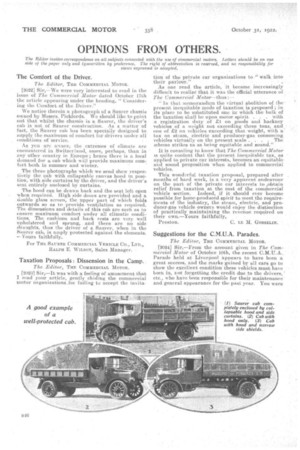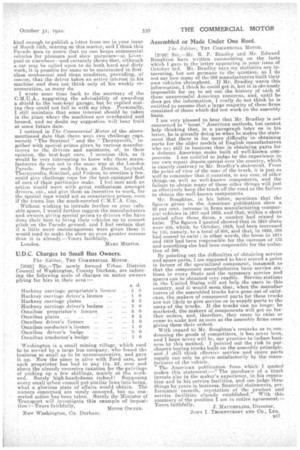OPINIONS FROM OTHERS.
Page 30

Page 31

If you've noticed an error in this article please click here to report it so we can fix it.
The Editor invites correspondence on all subjects connected ivitli the use of commercial motors. Letters should be on one side ol the paper only and typewritten by preference. The right of abbreviation is reserved, and no responsibility for views expressed is accepted.
The Comfort of the Driver.
The Editor, THE COMMERCIAL MOTOR.
[2022] Sir,—We were very interested to read in the
issue of The Commercial Motor dated October 17th the article 'appearing under the heading, " Considering the Comfort of the Driver."
• We notice therein a photograph of a Saurer chassis owned by Messrs. Pickfords. We should like to point out that whilst the chassis is a Saurer, the driver's cab is not of Saurer construction. As a matter of fact, the Saurer cab has been specially designed to supply the maximum of comfort for drivers under all conditions of -service.
As you are aware, the extremes of climate are encountered in Switzerland, more, perhaps, than in any other country in Europe ; hence there is a local demand for a cab which will provide maximum com-_ fort both in summer and winter.
The three photographs which we send show respectively the cab with collapsable canvas hood in position, with side curtains by the driver, and the driver's seat entirely enclosed by curtains.
The hood can be drawn back and the seat left open when required. High side doors are provided and a . double glass screen, the upper part of which folds outwards so as to provide ventilation as required. The dimensions and details of this cab are such as to ensure maximum comfort under all climatic conditions. The cushions and back rests are very well upholstered and sprung,, and there are no side draughts, thus the driver of a Saurer, when in the Saurer cab, is amply protected against the elements. --Yours faithfully.
For THE SATTRER COMMERCIAL VEHICLE CO., LTD., RALPH E. WILSON, Sales Manager.
Taxation Proposals : Dissension in the Camp..
The Editor, THE COMMERCIAL MOTOR.
120231 Sir,—It was with a feeling of amusement that I read your article, gently chiding the commercial motor organizations.for failing to accept the invita
tion of the private car organizations to .`.` walk into their parlour." As one read the article, it became increasingly difficult to realize that it was the official utterance of The Commercial Motor—thus:—
"In that memorandum the virtual abolition of the present inequitable mode of taxation is proposed ; in its place to be substituted one in which the bulk of the taxation shall be upon motor spirit . . . with a registration duty of LI on goods and hackney vehicles of a weight not exceeding three tons, and
one of on vehicles exceeding that weight, with a' tax on steam, electric and producer-gas consuming vehicles virtually on the present scale . . . . The scheme strikes us an being equitable and sound."
It is consoling to know that The Commercial Motor is quite content that the present inequitable tax, as applied to private car interests, becomes an equitable and sound proposition when applied to commercial vehicles.
This wonderful taxation proposal, prepared after months of hard work, is a very apparent endeavour on the part of the private car interests to Atain relief from taxation at the cost of the commercial vehicle section. Indeed, if it should ever become possible for home-produced spirit to meet the require. ments of the industry, the steam, electric, and producer-gas vehicle owners would enjoy the distinction of practically maintaining the revenue required on their own.—Yours faithfully,
Preston. C. LE M. GOSEELIN.
Suggestions for the C.M.U.A. Parades.
The Editor, THE COMMERCIAL MOTOR.
. 12024] Sir,—From the account given in The Commercial Motor of October. 10th, the recent C.M.U.A. Parade held at Liverpool appears to have been a great success, and the marks gainedby all cars go to show the excellent condition' these vehicles must, have been in, not forgetting the credit due to the drivers,' etc., who have been responsible for their maintenance and general appearance for the past year. You were
kind enough to publish a letter from me in your issue of March 14th, bearing on this matter, and I think this Parade goes to prove that no one keeps commercial vehicles for pleasure and show purpcses—at Liverpool or elsewhere--and certainly shows that, although a car may be called upon to do both hard and dirty work, it is possible for same to be maintained in firstclass mechanical and clean condition, providing, of course, that the driver takes an active interest in his machine and does not think only of his weekly remuneration, as many do.
I wrote some time back to the secretary of the C.M.U.A., suggesting the advisability of awarding a shield to the best-kept garage, but he replied stating they could not fall in with my idea. Personally, I still maintain that some interest should be taken in the place where the machines are overhauled and housed, and no doubt my suggestion will bear fruit at some future date.
I noticed in The Commercial Motor of the abovementioned date that there were two challenge eu,ps, namely "The Sentinel " and the " Thernyeroft,'! together with special prizes given by various manufacturers to the drivers and assistants, of, in their opinion, the best-kept cars. I mention this, as it would be very interesting to know why these manufacturers do not act in the same way at the London Parade. Surely such firms as Dennis, Leyland, Thornycrofts, Sentinel, and Fodens, to mention a few, eould give challenge cups for the best-equipped fleet of cars of their particular make. I feel sure such an action would meet with great enthusiasm amongst drivers, etc., and give them an incentive to work, for the special cups would act as -consolation prizes, even if the teams lost the much-coveted C.M.U.A. Cup.
Without wishing to intrude further on your valuable space, I would further suggest the manufacturers and owners giving special prizes to drivers who have done their best to bring their vehicles up to concert pitch on the Parade ground, and I feel certain that if a little more encouragement were given them it would tend to make the show an even greater success than it is already.—Yours faithfully,
London. MARC MEETON.
U.D.C. Charges to Small Bus Owners.
The Editor,. THE COMMERCIAL MOTOR.
[20251 Sir,—The newly formed Urban District Council of Washington, County Durham, are enforcing the following scale of charges on motor owners plying for hire in their area:— Washington is a small mining Village, which used to be served by a large bus company, who found the business so small as to be unremunerative, and gave it up. Now the place is alive • with Ford ears, and each proprietor has had to pay us. 3d. over and above the already excessive taxation for the privilege of picking up-a few shillings, mainly at the weekend. Surely high-handedness indeed • Supposing every small urban council put similarlaws into being, what a glorious state of affairs would obtain. The owners concerned are sorely annoyed, but no concerted action has been taken. Surely the Minister of Transport will investigate this example of imposition !—Yours faithfully,
MOTOR OWNER.
New Washington, Co. Durham.
Assembled or Made Under One Roof.
7/re Editor, THE COM:■IERCIAL filoTott.
[2026] Sir,—Mr. R. P. Bradley and Mr. Edward Boughton have written commenting on the facts i which I gave in the letter appearing n your issue of October 3rd. Mr. Bradleysays my statistics are interesting, but not germane to the question, as I do not say how many of the 388 manufacturers built their own vehicles throughout. If Mr. Bradley wants this information, I think he could get it, but it is obviously impossible for me to set out the history of each of these unsuccessful American concerns, and, until he does get the information, I really do not think he is entitled to assume that a large majority of these firms consisted of those which did not work on the assembly basis.
I am very pleased to hear that Mr. Bradley is not concerned to " boost " American methods, but cannot help thinking that, in a paragraph later on in his letter, he is actually doing so when he makes the statement that there is far more difficulty' in obtaining parts for the older models of English manufacturers who are still in business than in obtaining parts for a defunct American make built of well-known cornponents. I am entit!ed to judge by the experience in our own repair depote spread over the country, which is exactly contrary to Mr. Bradley's statement. From the point of view of the user of the truck, it is just as well to remember that it consists, in any case, of other things ‘.as,well as well-known components, and the failure to obtain many of these other things will just as effectively keep the truck off the road as the failure to obtain the well-known components.
Mr. Boughton, in his letter, mentions that the figures given in the American publication show a 25 per cent. increase in firms manufacturing commercial vehicles in 1918 and 1919, and that, within a short period after these dates, a number had ceased to exist. The figures I quoted showed that in 1918 there were 555, which, by October, 1919, had been increased by 133, namely, to a total of 688, and that, in 1922, 388 had ceased to exist ; in other words, the boom in 1918 and 1919 had been responsible for the increase of 133 and something else had been responsible for the reduction of 388.
By poinfing out the difficulties of obtaining service and spare parts, I am supposed to have scored a point in favour of the specialized component, inasmuch as that the component manufacturers 'have service stations in every State and the necessary service and spares can be obtained very readily. Service stations in the United States will not help the users in this country, and it would Seem. that., when the manuface turers of the assembled trucks have gone out of existence, the makers of component parts for these trucks are not likely to give service or to supply parts to the users of the trucks. If the trucks can no longer be marketed, the makers of components will get no further orders, and, therefore, they cease to exist, or cease to make just as soon as the assembly firms cease giving them their orders.
With regard to Mr. Boughton's remarks as to condemning the goods of competitors, it has never been, and I hope never will be, our practice to induce business by this method, I pointed out the risk to purchasers buying trucks built on the assembly principle, and still think effective serviee and spare parts supply can only be given satisfactorily by the manufacturer of the vehicle.
The Anieriean publication from which / quoted makes this statement:—" The purcbas-r of a truck invests also in the maker's experience, .irehis reputation and in his service facilities, and can judge these things by. years in business, financial statements, perfofmance records, reputation . of the product and service facilities alr-ead3r established," With this summary of the position I am in entire agreement.— Yours faithfully,
3. MAITGEFLING, Director, SOHN I. THORNYCROFT AND CO., LTD.


































